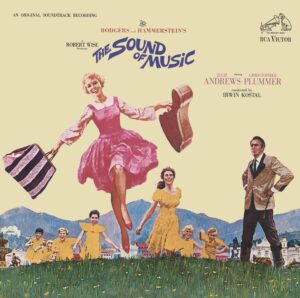RCA 2005
Producer: Neely Plumb
Track listing: Prelude and the Sound of Music [Maria] / Overture and Preludium (Dixit Dominus) [Orchestra and Nuns Chorus] / Morning Hymn and Alleluia [Nuns Chorus] / Maria [Nuns Chorus] / I Have Confidence [Mario] / Sixteen Going on Seventeen [Rolf and Liesl] / My Favorite Things [Mario] / Do-Re-Mi [Maria and the Children] / The Sound of Music [The Children and the Captain] / The Lonely Goatherd [Maria and the Children] / So Long, Farewell [The Children] / Climb Ev’ry Mountain [Mother Abbess] / Something Good [Maria and the Captain] / Processional and Maria (Organ, Orchestra, and Nuns Chorus] / Edelweiss [The Captain, Maria, the Children, and Chorus] / Climb Ev’ry Mountain (Reprise) [Chorus and Orchestra]

November 13, 1965
2 weeks
More than five years after the original cast recording of The Sound of Music topped the album chart, the soundtrack from the film version of the classic tale hit the chart.
The Sound of Music wasn’t composer Richard Rodgers and lyricist Oscar Hammerstein II’s first chart-topping effort. The team had first hit the summit with the soundtrack to the The King and I in 1956. That was followed by South Pacific in 1958 and the original cast album to Flower Drum Song a year later.
It also was not the first time Julie Andrews, who replaced Mary Martin in the lead role as Maria in the film version of The Sound of Music, had topped the chart. Andrews’s vocals were a key element in the Number One original cast albums to My Fair Lady, Camelot, and the soundtrack to Mary Poppins.
Also involved in the soundtrack were director Robert Wise, orchestrator Irwin Kostal, and musical supervisor associate producer Saul Chaplin, all of whom worked on West Side Story. Another player involved was screenwriter Ernest Lehman, who spearheaded the plan to bring The Sound of Music to the big screen, having proven successful with The King and I.
Yet Lehman just didn’t want to duplicate the stage version of the musical. He eliminated the songs “No Way to Stop It” and “How Can Love Survive?,” moved “My Favorite Things” and “Do-Re-Mi” to other scenes, and replaced the ballad “An Ordinary Couple” with a Rodgers song called “Something Good.”
In early 1964, production on the soundtrack began at 20th Century Fox. Andrews had seen the musical on Broadway, so she was well aware of Mary Martin’s performance. However, she never listened to the original cast recording prior to recording the soundtrack. “I didn’t consciously try to be different,” Andrews says. “I just tried to serve the music and the lyrics as best as I could.”
Recording the songs before the actual scenes for the film were shot was a challenge for Andrews. “The things I most remember were the difficulties of trying to convey the correct emotions about mountains, sounds of the countryside, and the joy of what one sees without actually having seen them first,” she says.
Yet even before the songs were recorded, the scenes had been painstakingly planned out. “The locales in the musical numbers had been well researched before we recorded the songs,” Andrews says. “For example, we knew how many steps to climb, or that we would be running along a covered arbor, or dancing around a fountain.”
One of Andrews’s favorite songs from the soundtrack is the shortest track on the album. “I have always been very fond of ‘Edelweiss,’ even though I barely sang it in the film,” she says.
The soundtrack version of the The Sound of Music hit the summit in its 35th week on the chart. Although it only stayed at Number One for two weeks, it went on to become one of the best-selling and most-loved soundtracks of all time, with a total of 233 weeks on the chart.
THE TOP FIVE
Week of November 13, 1965
1. The Sound of Music, Soundtrack
2. Help!, The Beatles
3. The In Crowd, Ramsey Lewis Trio
4. Whipped Cream & Other Delights, Herb Alpert & the Tijuana Brass
5. Highway 61, Revisited Bob Dylan
